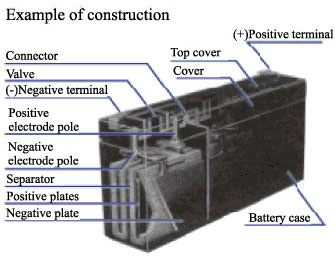Positive plates are plate electrodes of which a grid frame of lead-tin-calcium alloy holds porous lead dioxide as the active material.
Negative plates are plate electrodes of which a grid frame of lead-tin-calcium alloy holds spongy lead as the active material.
Diluted sulfuric acid is used as the medium for conducting ions in the electrochemical reaction in the battery.
Separators, which retain electrolyte and prevent shorting between positive and negative plates, adopt a non-woven fabric of fine glass fibers which is chemically stable in the diluted sulfuric acid electrolyte. Being highly porous, separators retain electrolyte, for the reaction of active materials in the plates.
The valve is comprised of a one-way valve made of material such as neoprene. When gas is generated in the battery under extreme overcharge condition due to erroneous charging, charger malfunctions or other abnormalities, the vent valve opens to release excessive pressure in the battery and maintain the gas pressure within specific range (0.07 to 0.43 kPa, or 1 to 6 psi). During the ordinary use of the battery, the vent valve is closed to shut out outside air and prevent oxygen in the air from reacting with the active material in the negative electrodes.
Positive and negative electrode terminals may be fasten tab type, bolt fastening type, threaded post type, or lead wire type, depending on the type of the battery. Sealing of the terminal is achieved by structure which secures long adhesive-embedded paths and by the adoption of strong epoxy adhesives.
 Material of the body and cover of the battery case are ABS
resins, unless otherwise specified.
Material of the body and cover of the battery case are ABS
resins, unless otherwise specified.
Email: PowerRite Technical Support
Phone: (877) 797-7483